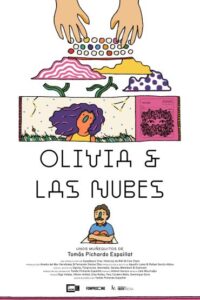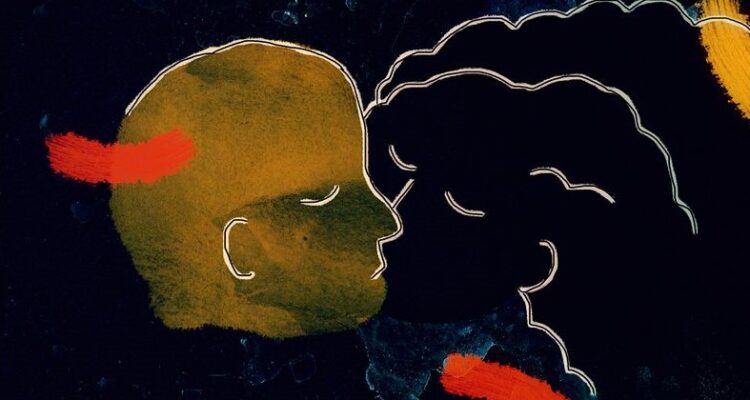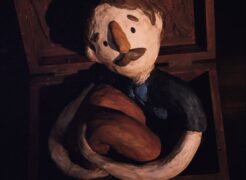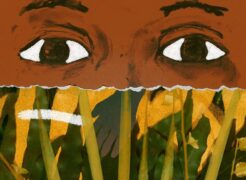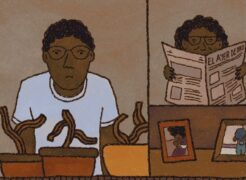Inhalt / Kritik
So richtig will sich Ramon beim Gespräch mit einem Kollegen nicht festlegen, ob er jemanden sieht. Er lässt nur durchschimmern, dass es da jemanden gibt. Aus gutem Grund. Sicher, er ist nicht der Einzige, der mit Pflanzen spricht. Doch während andere das in dem Glauben tun, dass diese dadurch besser wachsen, sieht Ramon in ihr das Mädchen, das ihm nicht mehr aus dem Kopf geht und dem die Pflanze zunehmend ähnlich sieht. Olivia, so hat er seine Topfpflanze genannt, spricht dabei auch mit ihm, wenn sie nicht gerade Wolken anschaut oder davon träumt, auf den Jupiter zu fliegen. Dabei ist Ramon nicht der Einzige, der sich mit komplizierten Gefühlen herumplagt, auch die echte Olivia, Barbara und Mauricio haben auf ihre Weise mit der Liebe zu kämpfen …
Alltägliche Themen, ungewöhnlich verpackt
Wer anhand der obigen Beschreibung erst einmal ein wenig verwirrt ist, sollte sich besser ebenso warm anziehen wie die botanische Olivia, die Kleidung braucht, weil ihr kalt ist. Denn die Geschichte um eine Mann-Pflanze-Beziehung ist nur einer von mehreren Strängen in Olivia & the Clouds, die sehr eigenwillig sind. Der Animationsfilm aus der Dominikanischen Republik nimmt zwar im Grunde sehr alltägliche Themen, wenn es um Liebe geht, um unerwiderte Gefühle, aber auch den Umgang mit unseren Erinnerungen und wie diese uns prägen. Er tut dies aber auf eine Weise, die alles andere als alltäglich ist. Stattdessen ist der Film, der auf dem Locarno Film Festival 2024 Premiere feierte, ein Feuerwerk aus Ideen.
Das betrifft einerseits den Inhalt, den man nur schwer zusammenfassen kann. Regisseur und Drehbuchautor Tomás Pichardo-Espaillat kombiniert in seinem Langfilmdebüt mehrere Stränge, die sich alle irgendwie mit der Liebe befassen. Das erinnert ein wenig an Our Crazy Love, das einige Wochen zuvor Premiere feierte. In beiden Animationsfilmen geht es um Beziehungen, reale wie eingebildete, geht es um Vergessen und Selbstsuche. Während der brasilianische Kollege aber einen humorvollen Ton pflegt, geht es bei Olivia & the Clouds melancholischer zu. Da mag dann zwar auch einiges irgendwie witzig sein, ohne dass daraus jedoch eine Komödie würde. Außerdem verzichtet Pichardo-Espaillat darauf, diese Stränge unbedingt zu einem Happy End zusammenfügen zu müssen. So kommt es zwar zu Berührungspunkten, der Film ist aber mehr eine Anthologie als durchgängige Geschichte.
Experimentelle und emotionale Reise
Visuell ist Olivia & the Clouds ebenfalls fragmentarisch, wenn Pichardo-Espaillat die unterschiedlichsten Techniken und Stile verwendet. Da trifft klassischer Zeichentrick auf Stop-Motion oder auch Realaufnahmen. Die Grenzen sind dabei fließend, sowohl innerhalb einer Szene wie bei den Übergängen. Nicht einmal die Figuren sind dabei zwangsläufig konstant, können sich vom einen Moment zum nächsten verändern. Der Film richtet sich damit eindeutig an ein Publikum, das Gefallen an eher experimentellen Werken hat, die schon mal ins Surreale gehen können. Er zeigt auf, dass es mit genügend Einfallsreichtum und Kreativität gar nicht so viel braucht, um ungewöhnliche Bilder zu erzeugen. Wer genug hat von den vielen gleichförmigen CGI-Abenteuern, die in den Kinos laufen, sollte diesem Geheimtipp eine Chance geben.
Wer hingegen ein klares narratives Werk braucht, könnte hiermit überfordert sind. Immer wieder hat man den Eindruck, dass die visuellen Spielereien im Vordergrund stehen, es also mehr um das Experimentieren als das Erzählen geht. Obwohl einige der Geschichten durchaus emotional sind, kann es schon passieren, dass durch die gewöhnungsbedürftige Optik der Zugang versperrt bleibt. Das ist schade, weil die Themen ganz losgelöst von dem Äußeren interessant und spannend sind. Aber auch wenn Olivia & the Clouds kein Film für das große Publikum ist, eher auf Festivals ein Zuhause finden wird als in regulären Kinos, ist Pichardo-Espaillat ein sehr interessantes Debüt geglückt, das neugierig darauf macht, wie seine filmische Reise weitergehen wird.
English review
When talking to a colleague, Ramon doesn’t really want to decide whether he is seeing someone. He only reluctantly mentions that there is someone. For good reason. Sure, he’s not the only one who talks to plants. But while others do this in the belief that they will grow better, Ramon sees his plant as the girl he can’t get out of his head and who the plant increasingly looks like. Olivia, that’s what he called his potted plant, also talks to him if she isn’t too busy looking at clouds or dreaming about flying to Jupiter. Ramon isn’t the only one struggling with complicated feelings, the real Olivia, Barbara and Mauricio also struggle with love in their own way…
Everyday topics, packaged in unusual ways
If you’re a little confused by the description above, you’d better prepare properly just like botanical Olivia, who needs clothes because she’s cold. After all the story about a man-plant relationship is just one of several strands in Olivia & the Clouds that are very idiosyncratic. The animated film from the Dominican Republic basically takes on everyday topics when it comes to love, unrequited feelings, but also how we deal with our memories and how they shape us. But he does this in a way that is anything but everyday. Instead, the film, which premiered at the 2024 Locarno Film Festival, is a fireworks display of ideas.
On the one hand, this concerns the content, which is difficult to summarize. In his feature film debut, director and screenwriter Tomás Pichardo-Espaillat combines several strands that all deal with love in some way. This is somewhat reminiscent of Our Crazy Love, which premiered a few weeks earlier. Both animated films are about relationships, both real and imagined, about forgetting and searching for oneself. While the Brazilian colleague maintains a humorous tone, Olivia & the Clouds is more melancholic. Some things may be funny in a way, but without becoming a comedy. Pichardo-Espaillat also avoids having to necessarily tie these strands together into a happy ending. There are points of contact, but the film is more of an anthology than a continuous story.
Experimental and emotional journey
Visually, Olivia & the Clouds is also fragmentary, with Pichardo-Espaillat using a variety of techniques and styles. Classic animation meets stop motion or real footage. The boundaries are fluid, both within a scene and in transitions. Not even the characters are necessarily constant; they can change from one moment to the next. The film is clearly aimed at an audience that enjoys more experimental works that can sometimes go into the surreal. He shows that with enough ingenuity and creativity, it doesn’t take that much to create unusual images. If you’ve had enough of the many samey CGI adventures showing in cinemas, you should give this insider tip a chance.
However, anyone who needs a clear narrative work might be overwhelmed by this. Again and again you get the impression that the visual games are in the foreground, so it’s more about experimenting than telling stories. Although some of the stories are quite emotional, it can happen that access remains blocked due to the visuals, which take some getting used to. That’s a shame because the topics are interesting and exciting, completely independent of the external appearance. But even if Olivia & the Clouds is not a film for the general public and is more likely to find a home at festivals than in regular cinemas, Pichardo-Espaillat has made a very interesting debut that makes you curious about how his cinematic journey will continue.
Credits
OT: „Olivia & Las Nubes“
Land / Country: Dominikanische Republik / Dominican Republic
Jahr / Year: 2024
Regie / Director: Tomás Pichardo-Espaillat
Drehbuch / Screenplay: Tomás Pichardo-Espaillat
Musik / Music: Cem Misirlioğlu
Kaufen / Streamen
Bei diesen Links handelt es sich um sogenannte Affiliate-Links. Bei einem Kauf über diesen Link erhalten wir eine Provision, ohne dass für euch Mehrkosten entstehen. Auf diese Weise könnt ihr unsere Seite unterstützen.
